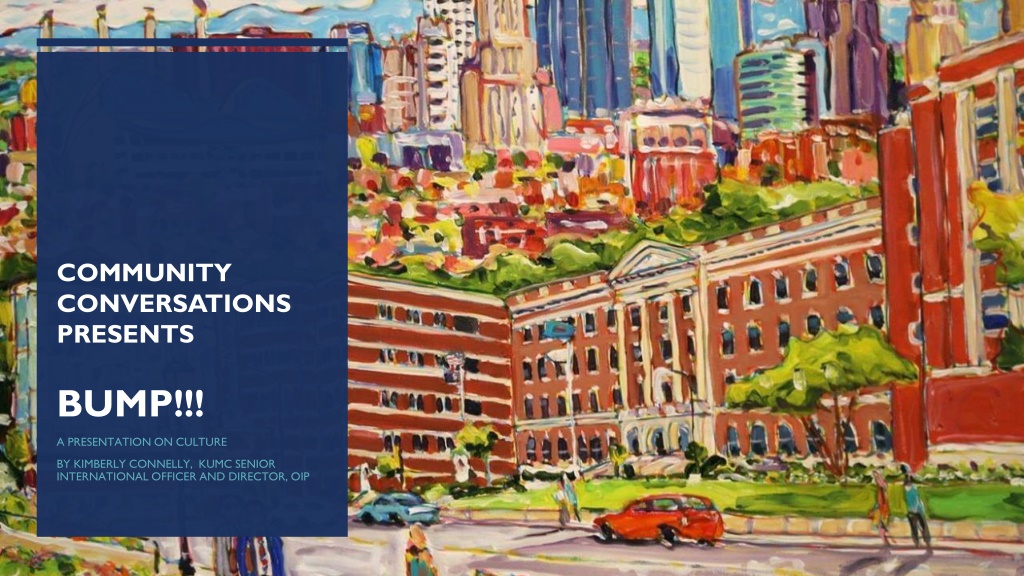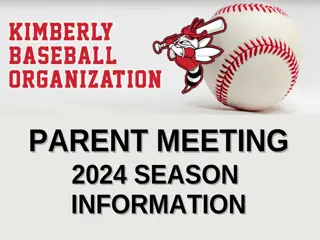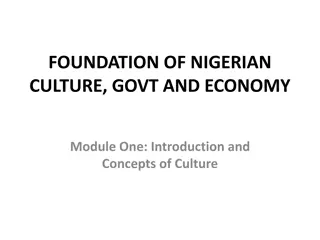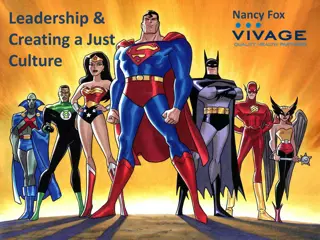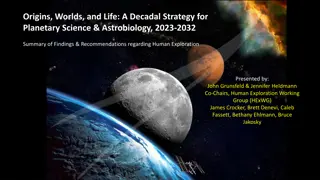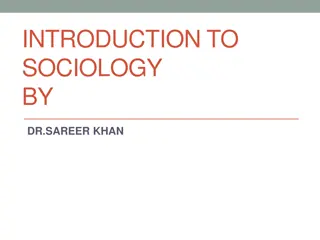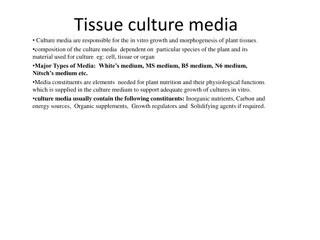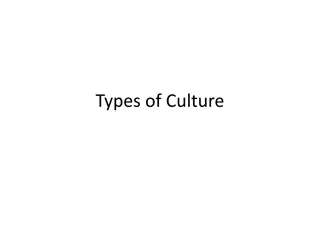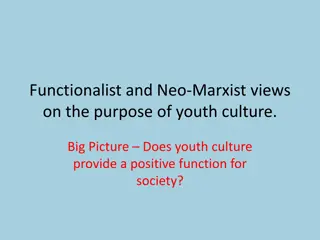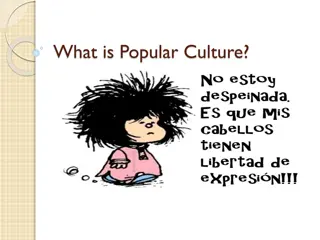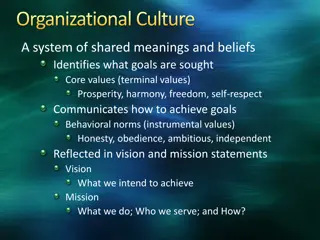Culture: An Exploration by Kimberly Connelly
Kimberly Connelly, an experienced international officer, presents insights into culture through her personal journey and the Iceberg Metaphor of Culture. She discusses Edward T. Hall's Cultural Iceberg Model, highlighting the hidden aspects of culture and the importance of actively engaging with different cultures to truly understand them. Join her on a deep dive into the complexities of cultural diversity and the need for open-minded interactions.
Download Presentation

Please find below an Image/Link to download the presentation.
The content on the website is provided AS IS for your information and personal use only. It may not be sold, licensed, or shared on other websites without obtaining consent from the author.If you encounter any issues during the download, it is possible that the publisher has removed the file from their server.
You are allowed to download the files provided on this website for personal or commercial use, subject to the condition that they are used lawfully. All files are the property of their respective owners.
The content on the website is provided AS IS for your information and personal use only. It may not be sold, licensed, or shared on other websites without obtaining consent from the author.
E N D
Presentation Transcript
COMMUNITY CONVERSATIONS PRESENTS BUMP!!! A PRESENTATION ON CULTURE BY KIMBERLY CONNELLY, KUMC SENIOR INTERNATIONAL OFFICER AND DIRECTOR, OIP
ME AND MY DISCLAIMER Interest in culture began in grade school with Vietnamese family friends; Studied French in high school and college Spent my junior summer in Belgium; Lived on the tiny island of Pohnpei, the Federated States of Micronesia, 7 degrees above the equator (3,823 miles from KC to Hawaii and another 3,216 miles from Hawaii to Pohnpei); Married a Pohnpeian (now divorced and remarried). Taught ESL for 20 years and have had taught international students and worked with internationals from +/- 125 different countries. I am not an expert on any culture. I attempt to know myself, my rules and my expectations which are formed by my personal experiences starting with my family.
IN YOUR OWN WORDS, WHAT IS CULTURE?
EDWARD T. HALLS CULTURAL ICEBERG MODEL There are major differences between the conscious and unconscious culture. Edward T. Hall s Cultural Iceberg Model In 1976, Hall developed the iceberg analogy of culture. If the culture of a society was the iceberg, Hall reasoned, than there are some aspects visible, above the water, but there is a larger portion hidden beneath the surface. What does that mean? The external, or conscious, part of culture is what we can see and is the tip of the iceberg and includes behaviors and some beliefs. The internal, or subconscious, part of culture is below the surface of a society and includes some beliefs and the values and thought patterns that underlie behavior. Internal vs. External Internal: Implicitly Learned, Unconscious, Difficult to Change, Subjective Knowledge External: Explicitly Learned, Conscious, Easily Changed, Objective Knowledge
WE MUST TAKE THE TIME TO GET TO KNOW INDIVIDUALS FROM THAT CULTURE AND INTERACT WITH THEM. Hall suggests that the only way to learn the internal culture of others is to actively participate in their culture. When one first enters a new culture, only the most overt behaviors are apparent. As one spends more time in that new culture, the underlying beliefs, values, and thought patterns that dictate that behavior will be uncovered. What this model teaches us is that we cannot judge a new culture based only on what we see when we first enter it. We must take the time to get to know individuals from that culture and interact with them. Only by doing so can we uncover the values and beliefs that underlie the behavior of that society. Source: Beyond Culture (1976) by Edward T. Hall
NITZA HIDALGOS THREE LEVELS OF CULTURE Concrete: This is the most visible and tangible level of culture, and includes the most surface-level dimensions such as clothes, music, food, games, etc. These aspects of culture are often those which provide the focus for multicultural "festivals" or "celebrations." Behavioral: This level of culture clarifies how we define our social roles, the language we speak, and our approaches to nonverbal communication. The Behavioral level REFLECTS our values. Aspects to be listed in this category include language, gender roles, family structure, political affiliation, and other items that situation us organizationally in society. Symbolic: This level of culture includes our values and beliefs. It can be abstract, but it is most often the key to how individuals define themselves. It includes values systems, customs, spirituality, religion, worldview, beliefs, mores, etc.
CULTURE: ITS ALL ABOUT YOU SHARE about yourself What culture (group) or cultures (groups) do you belong to that form your world view, rules and expectations? Draw a symbol that represents your culture or an aspect of your culture. Share with a partner.
CULTURE BUMPS: CASE STUDIES Read Discuss/Analyze with a partner: What was your initial reaction? What does that reveal about your culture, rules and expectations? What are the possible rules, assumptions or cultural values that are in conflict? Where would this fall on the Iceberg of Culture ? Share as a group
An American is attending church for the first time in another country with her host family. When she is informed that it is time to go to church, she walks up the mountain with her family. It s mid-morning, so she expects church will start at about 10:00 am. When she and her family arrive, they join everyone else and all sit outside around the church in the shade. Everyone is talking and hanging out. An hour or so passes, but there is no indication of when church will begin. The American is a bit confused about when church will begin. Finally, she asks a person when the church service is expected to begin. The person very matter-of- factly answers, When everyone gets here. WHAT IN THE WORLD?!? A CASE STUDY OF CULTURE
An American volunteer on the tiny island of Pohnpei in the Federated States of Micronesia is often confused and offended. Every time she walks past a person s house even a complete stranger the person says, Come and eat. She isn t sure how to respond And every time she sees anyone, the person asks, Where are you going? Sometimes she is walking to the bathroom...She always tells people where she is going, but she feels her destination or what she is doing is no one s business. Although she thinks Pohnpeians are very nice people, she feels that they are a bit nosy. WHAT IN THE WORLD?!? A CASE STUDY OF CULTURE
CULTURE BUMPS In your own words, what is a Culture Bump? Can you avoid them? How do you handle them?
CULTURE BUMPS DEFINED When encountering individuals from a culture other than our own, we are inevitably faced with situations that are confusing, upsetting, embarrassing or even offensive. Our assumptions, expectations or rules of behavior conflict These situations are called CULTURE BUMPS because two cultures have bumped into each other causing the exchange to be bumpy or not smooth or comfortable.
A newly arrived volunteer is working in another country at a high school and has been assigned as an advisor to the student government organization along with a local man who has been teaching at the school for for many years and also serves as the vice principal. The new volunteer suggests that they meet on Saturday at 3:00 to discuss activities and plans for the student government organization. She believes that the vice principal agreed to the meeting. On Saturday, the volunteer waits for the vice principal at the appointed time and place, but finally leaves at 4:30. When she asks the vice principal about it on Monday, he tells her she should know when yes means yes and yes means no. WHAT IN THE WORLD?!? A CASE STUDY OF CULTURE
LOW-CONTEXT CULTURE VS. HIGH CONTEXT In general, is America a Low-Context or High-Context culture?
LOW CONTEXT VS HIGH CONTEXT CULTURE High-Context Culture 1. Implicitly embeds meanings at different levels of the sociocultural context. 2. Values group sense. 3. Tends to take time to cultivate and establish a permanent personal relationship. 4. Emphasizes spiral logic. 5. Values indirect verbal interaction and is more able to read nonverbal expressions. 6. Tends to use more "feeling" in expression. Low-Context Culture (US) 1. Overtly displays meanings through direct communication forms. 2. Values individualism. 3. Tends to develop transitory personal relationship. 4. Emphasizes linear logic. 5. Values direct verbal interaction and is less able to read nonverbal expressions. 6. Tends to use "logic" to present ideas. 7. Tends to emphasize highly structured messages, give details, and place great stress on words and technical signs. 7. Tends to give simple, ambiguous, noncontexting messages.
WHAT IN THE WORLD?!? A CASE STUDY OF CULTURE A girl who has just arrived in Kansas City from Kenya is surprised at how friendly everyone is! Everyone smiles at her. At first, this seems very odd to her, but she just assumes everyone really likes her. She cannot believe how many people want to be her friend. She is disappointed three weeks into being at her new university because everyone smiles at her and says Hi , but no one invites her to their home nor engages her in a meaningful conversation.
What is non-verbal communication? Definition (CBC): nonverbal communication involves those nonverbal stimuli in a communication setting that are generated by both the source [speaker] and his or her use of the environment and that have potential message value for the source or receiver [listener] (Samovar et al). Basically it is sending and receiving messages in a variety of ways without the use of verbal codes (words). It is both intentional and unintentional. Most speakers / listeners are not conscious of this. It includes but is not limited to: touch glance eye contact (gaze) volume vocal nuance proximity gestures facial expression ? pause (silence) intonation dress posture smell word choice and syntax sounds (paralanguage) http://www2.andrews.edu/~tidwell/bsad560/NonVerbal.html 90% of communication is non-verbal, and 100% of non-verbal is culturally contextual. Have you ever been confused by someone's non-verbal communication like gesture, tone of voice, touch etc?
CULTURE BUMPS: WHAT CAN WE DO? Understand that body language and all non-verbal communication are not universal Do not react with anger Try to give the person the benefit of the doubt and suspend judgment Ask for clarification Observe Remember intention is everything Be willing to apologize
What belief/assumption does each expression reflect or highlight? Everyone smiles in the same language. OUR CULTURAL VALUES You are color blind. There is no such thing as a free lunch. Curiosity killed the cat. The early bird catches the worm.
What are some of your values and how do you show them? For example, do you value RESPECT? OUR VALUES How do you show respect? List a couple
OUR PERSONAL VALUES What do you think: A teacher commented that her ESL student seemed to always be hiding something he seems so dishonest and simply disrespectful. Can you guess what the student was doing? What can you do if your value and someone else's value is the same but is contrary in how it is shown or conveyed?
WHAT OBSTRUCTS OUR UNDERSTANDING EACH OTHER? KNOWING what is true KNOWING our way is the only way or at least the only right way Lack of awareness of our self and our own culture, rules and expectations Being sure Our bias -- unconscious or even conscious bias QT EXAMPLE -- Our thoughts prevent us from hearing (or listening). https://www.youtube.com/watch?v=crAv5ttax2I
Starts with each of us Self-awareness Believing that there may be other ways CREATING A CULTURE OF INCLUSIVENESS Not being so sure Becoming aware of unconscious bias Being genuinely interested in others and other ways (you don t have to change your ways) Being inquisitive asking What are your rules? Observing closely Listening
